Disturbance and its Role in Plant Habitat Preferences
May 29th, 2025 by Alex Zorach
A critical and often neglected aspect of plants' habitat preferences is disturbance. Broadly speaking, a disturbance in an ecosystem is an event that changes the environment, usually harming and/or killing some plants in the process. Some examples of disturbances include flooding, drought, fire, landslide, logging, or a wind storm.Disturbances can be natural or anthropogenic (human-induced), and some, such as those related to climate change, result from an interplay between natural and anthropogenic factors. Disturbances can cover all spacial scales, from micro-disturbances such as a small animal digging a hole or a large animal treading on soil with its hooves, through slightly larger ones like a tree or a few trees being thrown by a windstorm, to massive scales like a broad region experiencing drought or a major volcanic eruption.
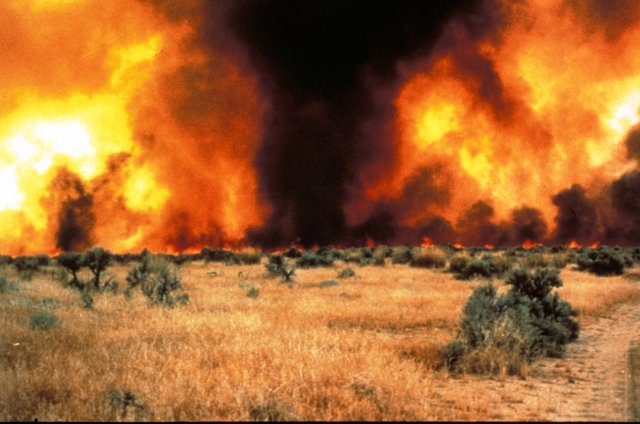 This wildfire near Mountain Home, Idaho, illustrates the interplay between natural and anthropogenic disturbances. Although the ecosystems here would have burned naturally, the introduction of an invasive species, cheatgrass (Bromus tectorum), has altered the fire dynamics, extending the fire season as it dries out earlier than native grasses, and often leading to more severe fires. Photo © U.S. Fish and Wildlife Service Headquarters, CC BY 2.0, Source.
This wildfire near Mountain Home, Idaho, illustrates the interplay between natural and anthropogenic disturbances. Although the ecosystems here would have burned naturally, the introduction of an invasive species, cheatgrass (Bromus tectorum), has altered the fire dynamics, extending the fire season as it dries out earlier than native grasses, and often leading to more severe fires. Photo © U.S. Fish and Wildlife Service Headquarters, CC BY 2.0, Source.Disturbance is not inherently good or bad, but it does shape what plants can grow and thrive in a particular environment. And, in the long-run, disturbance plays a key role in creating and maintaining biodiversity.
Understanding disturbance is key for working with plants in any setting, whether in gardening, landscaping, ecological restoration, or conservation work.
Specific Plants have Specific Adaptations to Specific Disturbances
When looking at the variety of plants in our natural environment, a question that arises is: "Why are there so many species? What makes each one different?" One of the key answers is adaptation to different disturbance regimes. For example, among the white oak group, post oak (Quercus stellata) is adapted to withstand both severe drought and fire, and as such, it resists both.At the other end of the spectrum, bottomland oaks such as overcup oak (Quercus lyrata) are adapted to withstand flooding. Interestingly though, there are many different white oaks that grow in bottomlands. Swamp white oak (Quercus bicolor) and swamp chestnut oak (Quercus michauxii) both are adapted to sites that flood less deeply than overcup oak. Overcup oak tends to grow on the lowest sites next to rivers, but it tends to grow on sites that flood primarily in late winter or spring. It leafs out significantly later than swamp white oak or swamp chestnut oak, allowing it to remain dormant during the period of most severe flooding. This adaptation allows it to inhabit lower, more flood-prone sites where those other two oaks could not survive. However, because it leafs out late, it has a disadvantage on slightly higher, drier sites, and these sites tend to be colonized by other oaks.
There are even white oaks adapted to both flooding and fire, such as bur oak (Quercus macrocarpa). Bur oak tends to be more common farther west, being dominant primarily in the Great Plains, from Texas north through KS, NE, MO, IO, MN, and surrounding states. This region is drier than regions to the east, so fewer trees at all are able to survive on uplands, with these sites instead supporting open prairie. And bottomland sites are such that they can be subjected to both flooding, and drought and wildfire.
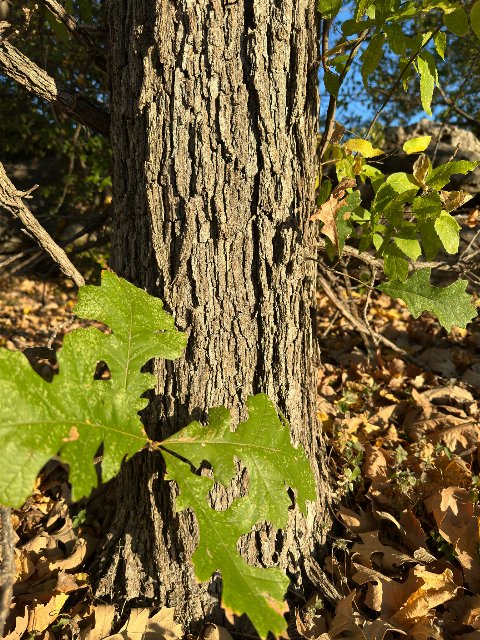 This picture illustrates multiple fire adaptations of Bur oak (Quercus macrocarpa). The thick bark insulates against fire. The distinctive leaf shape, with curving side-veins, makes dead leaves curl, causing them to sit upright on the ground. This leads the litter to dry out, even in the moist bottomlands where they occur. The dry litter promotes low-intensity ground fires, which protect the bur oak both by killing less fire-tolerant trees that might outcompete the bur oak, and also by removing fuel, so as to prevent more severe crown fire that the bur oak could not withstand. This mechanism is a key factor in the maintenance of bur oak savannas, common at the border of the Great Plains and Eastern Temperate Forests. Photo © Nathan Walther, CC BY 4.0, Source.
This picture illustrates multiple fire adaptations of Bur oak (Quercus macrocarpa). The thick bark insulates against fire. The distinctive leaf shape, with curving side-veins, makes dead leaves curl, causing them to sit upright on the ground. This leads the litter to dry out, even in the moist bottomlands where they occur. The dry litter promotes low-intensity ground fires, which protect the bur oak both by killing less fire-tolerant trees that might outcompete the bur oak, and also by removing fuel, so as to prevent more severe crown fire that the bur oak could not withstand. This mechanism is a key factor in the maintenance of bur oak savannas, common at the border of the Great Plains and Eastern Temperate Forests. Photo © Nathan Walther, CC BY 4.0, Source.These examples explore only a single limited taxon of plants (the white oaks) and their handling of a single type of disturbances: those related to the presence or absence of moisture, i.e. the spectrum of flooding vs. drought and fire. There are countless other taxa and countless other types of disturbances. Thinking from this perspective, it becomes easier to understand how and why there are thousands of plant species native to North America, and sometimes dozens even within a single genus.
Adaptation to Disturbances Has a Cost
Every adaptation to a challenge has a cost. The overcup oak gives up a few weeks of photosynthesis as a trade-off to better withstand deep spring flooding. The post oak grows slowly so that its foliage is not overextended in a drought, and mature trees grow thick bark to insulate against fire.Plants that forgo these adaptations will have an advantage in a habitat free from these stressors. For example, each of the sugar maple (Acer saccharum) and American beech (Fagus grandifolia) are poorly-adapted to both drought or flooding, requiring mesic (consistently moist but well-drained) conditions to thrive. But by avoiding the costly adaptations to drought or flooding, these trees achieve greater photosynthetic efficiency, and are among the most shade-tolerant of all trees in Eastern North America. In the absence of disturbance, they eventually replace most competing trees. Even their associate, the yellow birch (Betula alleghaniensis), relies on sunnier gaps created by a small disturbance such as a single tree dying, in order to establish.
Another example of such tradeoffs is seen in milkweeds. Whorled milkweed (Asclepias verticillata) is a pioneer species that is among the first colonizers of sunny, dry sites with poor soil, where a disturbance has cleared all vegetation. Its narrow leaves with little surface area make it able to withstand drought stress even before it has had time to establish much of a root system. But these leaves cannot capture much sunlight, which not only limits it to sunny sites, but makes it less competitive against other vegetation. At the other end of the spectrum, poke milkweed (Asclepias exaltata) has broad, thin leaves that are both outstanding at capturing light and inexpensive to manufacture, allowing it to persist in shade. But the thin leaves leave the plant so susceptible to drought stress that it typically can only survive on sites sheltered from wind. A disturbance that removed too many trees would probably eliminate it from a site.
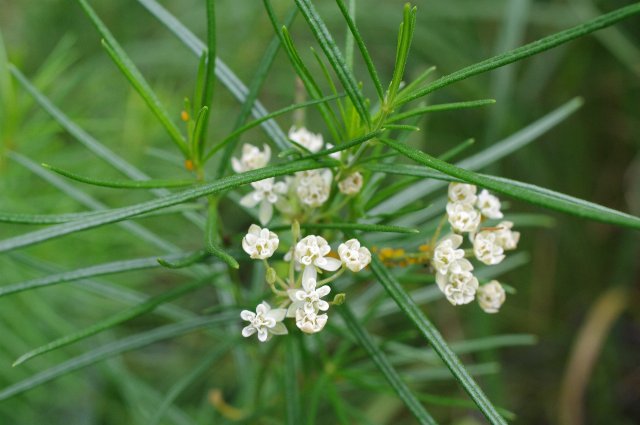 The narrow leaves of whorled whorled milkweed (Asclepias verticillata), with little surface area, help it resist drought stress, allowing it to colonize dry, sunny sites with poor soil. But these leaves come at the tradeoff of making it intolerant to shade and competition. As such, its niche is limited to being a pioneer species on sunny sites. Photo © Jeremy Atherton, CC BY 4.0, Source.
The narrow leaves of whorled whorled milkweed (Asclepias verticillata), with little surface area, help it resist drought stress, allowing it to colonize dry, sunny sites with poor soil. But these leaves come at the tradeoff of making it intolerant to shade and competition. As such, its niche is limited to being a pioneer species on sunny sites. Photo © Jeremy Atherton, CC BY 4.0, Source.The more one studies these matters, the more one realizes that the disturbances are inseparable from the plants. The adaptations to the various disturbances are reflected in the plant's morphology and behaviors (such as timing and growth responses) which in turn are encoded in the plant's genetics. To understand plants, you need to understand disturbances.
Learning the disturbances a plant is adapted to is as important as learning how to identify it by leaf or flower shape, and indeed, often goes hand-in-hand with learning its morphology because the morphology is an adaptation to its environment. And this is why, in our plant comparison and ID guides, you will find extensive discussion of disturbance and how the plant is adapted to it. Often, disturbance can be a key factor that can help you to identify a plant, as certain plants either will or won't be found on sites subjected to a particular type of disturbance. Understanding the relationship between adaptation and morphology can also help you remember how to identify a plant.
Periodic vs. One-time Disturbance & Succession
Disturbances can be periodic, and the degree of regularity of periodic disturbance can also vary. It is common for some rivers and streams to flood periodically, often in spring. At the same time, the severity of flooding may vary greatly from one year to the next. Drought and fire can also be periodic, but also vary both in intensity and frequency. When disturbance is frequent and regular, it creates a plant community adapted to the disturbance. These communities may include long-lived perennials or woody plants able to survive through the disturbance many times, and also annuals, biennials, or short-lived perennials that quickly germinate following the disturbance.One-time or rare disturbances create a different sort of environment. A rare disturbance will often kill most or all of the plants in an ecosystem, resetting the ecosystem back to a more barren state in which plants need to recolonize gradually. In some cases, such as when soil was washed away by a flood or landslide, severely burned by fire, or covered in a lava flow, the soil itself may need to accumulate or develop. Plants adapted to rare disturbances may exhibit traits such as long-term seed banking (common in legumes) or off-site dispersal (such as wind-, animal-, or flood-dispersed seeds) so they can establish on a site where all the vegetation has been removed.
 This savanna of longleaf pine (Pinus palustris) in North Carolina is a habitat that experiences regular fire; the regularity of the fire keeps the understory open, and limits fuel accumulation so that the fires are usually not severe enough to harm the mature trees. Such a fire regime is typical in the maintenance of savannas. Photo © John Kees, Public Domain, Source.
This savanna of longleaf pine (Pinus palustris) in North Carolina is a habitat that experiences regular fire; the regularity of the fire keeps the understory open, and limits fuel accumulation so that the fires are usually not severe enough to harm the mature trees. Such a fire regime is typical in the maintenance of savannas. Photo © John Kees, Public Domain, Source.The schedule or pattern of disturbance is not a function of the type of disturbance alone; the same type of disturbance can be regular in one environment and rare in another. For example, Florida scrub communities would naturally experience fire almost every year, triggered by lightning strikes at the end of the dry season. Because the fire is frequent, fuel accumulation, and thus fire severity, was limited. These communities support trees such as sand pine (Pinus clausa) and longleaf pine (Pinus palustris) that can survive such fire. On the other hand, Chaparral in the California Coastal Sage, Chaparral, and Oak Woodlands tends to experience infrequent, severe fire after years or even decades of fuel accumulation. Here fire kills almost everything, leading to a process where the plants gradually recolonize.
The process through which an ecosystem regrows following a major disturbance is called succession. The term succession is not used for regular disturbances, only rare, catastrophic ones. Early in succession, pioneer species colonize the site. Part of a plant's habitat preferences include which successional stages of the habitat it occurs in. For example, the red mulberry (Morus rubra), which grows in floodplain forests, typically shows up around 80-90 years after a major disturbance. These forests may experience flooding nearly every year, but these disturbances are not severe and generally leave most of the forest intact.
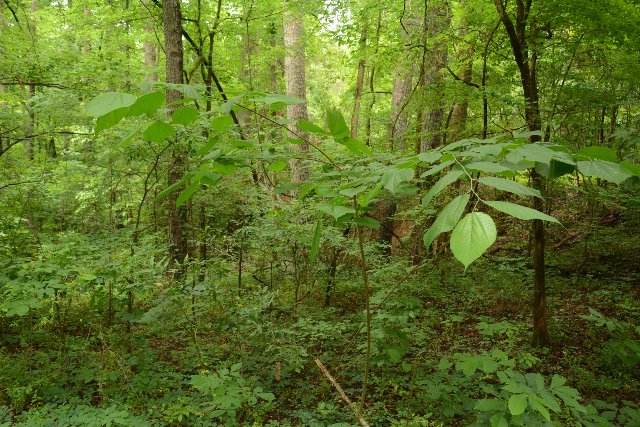 "Succession" typically refers only to catastrophic disturbance. The red mulberry (Morus rubra) typically only shows up in late-successional stages in bottomland forests, but here "succession" is understood to involve the establishment of trees able to withstand whatever regular disturbances, such as temporary flooding, the forest is subjected to. Note that this mulberry is much younger than the canopy trees.
"Succession" typically refers only to catastrophic disturbance. The red mulberry (Morus rubra) typically only shows up in late-successional stages in bottomland forests, but here "succession" is understood to involve the establishment of trees able to withstand whatever regular disturbances, such as temporary flooding, the forest is subjected to. Note that this mulberry is much younger than the canopy trees.Photo © Siddarth Machado, CC BY 4.0, Source.
Disturbance in Gardens and Managed Landscapes
Gardens and managed landscapes are subjected to regular, often heavy anthropogenic disturbance, which we can think of as managed disturbance. Mowing, weed-whacking, mulching, weeding, and herbicide use are some of the most common examples of disturbances that humans carry out on managed ecosystems.If you want plants to thrive in a managed landscape, you need to choose plants adapted to whatever disturbance regime you are carrying out on that landscape. For example, if you want plants to grow in a regularly-mowed lawn, they need to be adapted to mowing. Some native grasses, such as poverty oatgrass (Danthonia spicata), nimblewill (Muhlenbergia schreberi), and buffalo grass (Bouteloua dactyloides), can survive and thrive in lawns, as can some broadleaf plants, like the introduced white clover (Trifolium repens), or the native common blue violet (Viola sororia) or marsh blue violet (Viola cucullata). These broadleaf plants, however, will not survive in lawns treated with selective herbicides like triclopyr or 2,4-D.
Tilling or cultivation of soil is another type of disturbance, in which all of the surface soil on a site is agitated and mixed. Tilling tends to kill certain types of plants, while favoring others. Tilling usually promotes annuals by giving their seeds a space to germinate, whereas refraining from tilling favors perennials. However, shallow tilling can favor perennials with deep rhizomes, such as the persistent invasive japanese knotweed (Reynoutria japonica), creeping thistle (Cirsium arvense), or common mugwort (Artemisia vulgaris), as well as some native plants with similar growth habits such as tall goldenrod (Solidago altissima) or common milkweed (Asclepias syriaca).
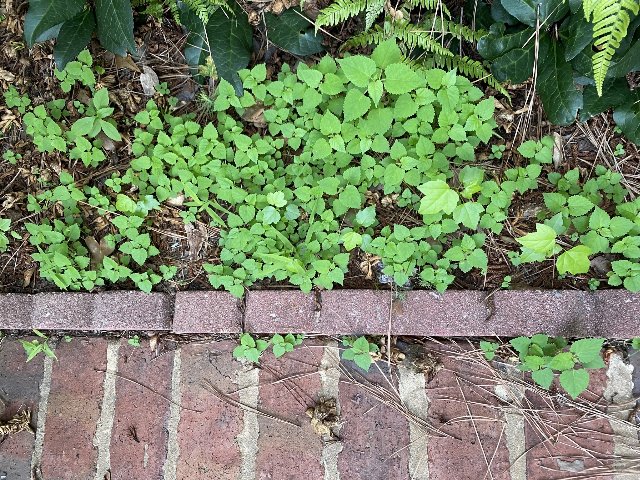 This photo shows hairy crabweed (Fatoua villosa) seedlings that have sprouted in exposed soil in a garden. The act of weeding continuously disturbs the soil, providing ideal habitat for such plants with short lifecycles that like exposed soil. Photo © Emily Summerbell, CC BY 4.0, Source.
This photo shows hairy crabweed (Fatoua villosa) seedlings that have sprouted in exposed soil in a garden. The act of weeding continuously disturbs the soil, providing ideal habitat for such plants with short lifecycles that like exposed soil. Photo © Emily Summerbell, CC BY 4.0, Source.A lot of gardeners shoot themselves in the foot by continually weeding their beds, effectively creating conditions where annual weedy plants thrive. Some plants, such as common groundsel (Senecio vulgaris) or hairy crabweed (Fatoua villosa) have such a short lifecycle, able to complete as many as 5 generations per growing season, that they are actively encouraged by frequent weeding. It is nearly impossible to keep up with these plants, because they are specifically adapted to frequent weeding and tilling, and they have often already produced seed by the time people notice them. Instead, they can be kept out by allowing perennial groundcovers to cover all exposed soil.
Natural disturbances can interact with the management of gardens and other landscapes. A typical yard will have its wet and dry spots. If you plant a flood-intolerant plant in a depression that perodically floods, it will die. Similarly, if you plant a drought-intolerant plant on a dry site, it will die unless you go out of your way to water it during droughts, and such watering can be costly and wasteful. Similarly, browsing pressure from mammals such as rabbits, deer, or groundhogs, can kill certain plants, especially those most palatable to these herbivores, whereas others, the more toxic and bitter-tasting ones, or ones with other defenses such as thorns or stinging hairs, will be more resistant. Intelligent, sustainable gardening demands knowing both the natural and managed disturbances your yard will be subjected to, and selecting the right plants to withstand those challenges.
Disturbance in Ecological Restoration Work
Understanding disturbance is key to doing ecological restoration work for multiple reasons. Every site has its particular unique set of disturbances that it experiences. A floodplain may experience regular deep, fast-moving flooding, but may rarely experience drought or fire. An upland site, however may experience more frequent drought, and some may experience occasional wildfire. An exposed hilltop may be more exposed to high winds, whereas coastal dunes are prone to salt spray, storm surge, and shifting sands.Semi-wild habitats can bring additional anthropogenic disturbances. A meadow under a power-line right of way may be subjected to periodic mowing and/or herbicide application. Sites adjacent to an area (such as cropland or railroad tracks) with heavy herbicide use may be subjected to occasional, irregular herbicide drift from the neighboring site. Highways and urban roadsides may have runoff from road salt in winter. A creek running through cropland may have nutrient pollution from agricultural fertilizers and resulting algal blooms, and a creek running through a formerly mined area may have acid mine drainage. And in general, waterways downstream from areas where land has been cleared and/or paved, and wetlands drained, will tend to experience more severe oscillations of water levels (including both flooding and drought) than natural watersheds with the vegetation cover intact.
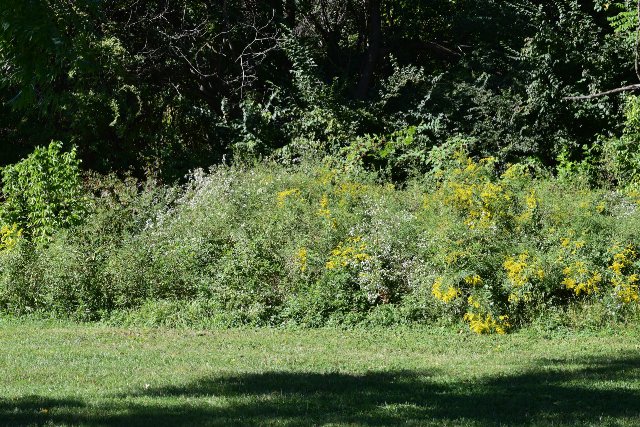 Anthropogenic edge habitats are semi-wild habitats that are widespread around human habitation. Here, a wild forest transitions to mowed grassland in a park. The maintenance of the edge creates disturbance through weedwhacking, bushhogging, pruning, and/or herbicide use. The absence of woody plants in the foreground provides evidence that this site experiences regular disturbance that removes all woody plants from within a few feet of the edge. Farther back, shrubby growth and perennial vines but no large trees shows that, within several years, a disturbance removed all woody plants a few feet farther back, but that woody plants have been allowed to grow up since then.
Anthropogenic edge habitats are semi-wild habitats that are widespread around human habitation. Here, a wild forest transitions to mowed grassland in a park. The maintenance of the edge creates disturbance through weedwhacking, bushhogging, pruning, and/or herbicide use. The absence of woody plants in the foreground provides evidence that this site experiences regular disturbance that removes all woody plants from within a few feet of the edge. Farther back, shrubby growth and perennial vines but no large trees shows that, within several years, a disturbance removed all woody plants a few feet farther back, but that woody plants have been allowed to grow up since then.Understanding the interplay between the management strategies and species present along the edge is key to controlling invasives and promoting native plant biodiversity in an edge habitat like this. Restoration techniques can involve the seeding or transplanting of new plants in, removal of invasives, and changing of the management regime.
Photo © Alex Zorach, CC BY-SA 4.0.
When re-vegetating a site, or seeding or transplanting plants in to re-establish the native flora or increase biodiversity, in order for the plants to persist long-term, plants must be chosen that are adapted to the site's disturbance patterns. In order to match a plant to the site, one must understand both the plants and the site.
Keep in mind that the disturbance regime is likely to have changed, so just because certain plants thrived on a site historically does not mean that it will always be possible to reestablish them. Some examples of why it may not be possible to restore the historic flora on a site include:
- Areas upstream in the watershed may have been cleared, leading to more severe flooding and/or water table oscillation.
- Topsoil may have been lost, degraded, or compacted, leading to lower water percolation into the soil and thus worsening of drought.
- Clearing of forests or trees on adjacent sites may expose the site to higher winds and more extreme temperatures.
- Anthropogenic disturbances, such as controlled burns, practiced by indigenous people may have been halted, and may not be legal and/or practical to bring back to the site.
- The site may face greater herbivory pressure, such as from deer overpopulation in suburban areas, or less herbivory, such as in areas of the Great Plains where bison have been extirpated.
- The climate may have changed in such a way that the habitat is now suited for different species than what originally grew there.
- The site may be subjected to new anthropogenic disturbances, such as herbicide, mowing, weedwhacking, or foot traffic or other use.
 In meadows mowed once a season, changing of the timing of mowing can favor certain vegetation over others. When meadows are dominated by non-native cool-season grasses such as this orchard grass (Dactylis glomerata), timing of mowing in spring, after they emerge but before seed matures, will reduce them and create space for the germination, establishment, and emergence of native warm-season grasses such as yellow indiangrass (Sorghastrum nutans), switchgrass (Panicum virgatum), and big bluestem (Andropogon gerardii), as well as native warm-season perennials such as tall goldenrod (Solidago altissima).
In meadows mowed once a season, changing of the timing of mowing can favor certain vegetation over others. When meadows are dominated by non-native cool-season grasses such as this orchard grass (Dactylis glomerata), timing of mowing in spring, after they emerge but before seed matures, will reduce them and create space for the germination, establishment, and emergence of native warm-season grasses such as yellow indiangrass (Sorghastrum nutans), switchgrass (Panicum virgatum), and big bluestem (Andropogon gerardii), as well as native warm-season perennials such as tall goldenrod (Solidago altissima).Alternatively, switching from mowing to a controlled burn regime may achieve a similar effect, in some cases even more effectively. However, such changes must be site-specific. On a site with fire-intolerant native plants and fire-tolerant invasives, fire would be harmful. And on a site with invasive warm-season grasses and native cool-season grasses, timing mowing later, to allow the cool-season grasses to mature and then cut the warm-season grasses before they set seed, might be optimal.
Photo © Brandon Corder, CC BY 4.0, Source.
The disturbances in our world will continue to change, both for natural reasons and through the actions of humans. We will achieve better results when we learn to work with these disturbances, picking plants able not only to withstand them, but to exploit or benefit from them.
Although greater knowledge can lead to better matching of plants to the site, there is no substitute for trial-and-error, which can be seen as the human side of the process of natural selection, a process that is always at work in wild ecosystems and is a large part of how plants evolve and adapt to their environment. We emphasize that, even with the articles on our site that are more-or-less "complete", research is best used only as a starting point. The vision of our site is that it will lead to real-world restoration efforts, and those efforts will inevitably involve experimentation and ongoing observation to figure out which methods work best.
Thank you!
Thank you to everyone who has read to the end of this lengthy post, for caring enough about these issues to do so. Thank you to everyone who takes the information in this post out into the world to do ecological restoration work. Thank you to everyone who pays attention to plants and observes their behavior in the real world enough to notice their different responses to disturbance. And thank you also to all the donors who continue supporting our work on this site!Archive of All Blogs
The Bias Against Tall Plants, November 11th, 2025
A Focus on Goldenrods (Solidago sp.), July 23rd, 2025
Disturbance and its Role in Plant Habitat Preferences, May 29th, 2025
What "Native" or "Introduced" Mean: Myths and Misconceptions, March 11th, 2025
Smarter & More Informative Search Results, January 13th, 2025
The Effect of the 2024 US Election on Plant Biodiversity and bplant.org, October 30th, 2024
The Problems With Nursery-Bought Plants, And The Solutions, October 8th, 2024
More Databases Linked & Search Improvements for Scientific Names, July 9th, 2024
Choosing The Best Common Names For Plants: Challenges & Solutions, April 19th, 2024
Range Map & Taxonomic Update Progress, January 31st, 2024
Giving Thanks To Everyone We Rely On, November 22nd, 2023
Thinking More Deeply About Habitat, April 5th, 2023
2022 Year-End Summary: Successes & New Goals, February 15th, 2023
New Databases Linked: Flora of North America & NatureServe Explorer, November 11th, 2022
All Range Maps 2nd Generation, Taxonomic Updates, & Fundraising Goal Met!, September 29th, 2022
More Range Map Improvements, POWO Interlinking, And Notes Fields, June 7th, 2022
Ecoregion-Based Plant Lists and Search, March 30th, 2022
Progress Updates on Range Maps and More, February 10th, 2022
The Vision for bplant.org, December 9th, 2021
New Server: Software & Hardware, August 30th, 2021
More & Improved Plant Range Maps, July 19th, 2021
A Control Section for Invasive Plants, April 15th, 2021
Progress Bars & State Ecoregion Legends, March 11th, 2021
Our 2020 Achievements, February 9th, 2021
Interlinking Databases for Plant Research, November 11th, 2020
A New Homepage, Highlighting Our Articles, July 29th, 2020
A False Recovery, But North Carolina's Ecoregions are Complete!, June 9th, 2020
We're Back After COVID-19 Setbacks, April 3rd, 2020
Help Us Find Ecoregion Photos, February 27th, 2020
What We Achieved in 2019, December 30th, 2019
Plant Comparison and ID Guides, October 30th, 2019
We Are Now Accepting Donations, October 14th, 2019
US State Ecoregion Maps, New Footer, Ecoregion Article Progress, and References, September 19th, 2019
Tentative Range Maps of Native Plants, August 12th, 2019
Ecoregion Locator and Interactive Maps, July 10th, 2019
Using Ecoregions Over Political Boundaries, May 13th, 2019
How We Handle Wild vs Cultivated Plants, April 16th, 2019
A Blog To Keep People Updated On Our Progress, April 8th, 2019
Sign Up
Want to get notified of our progress? Sign up for the bplant.org interest list!


